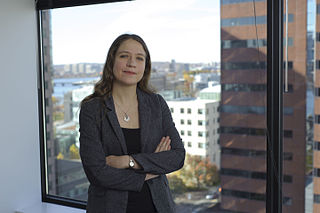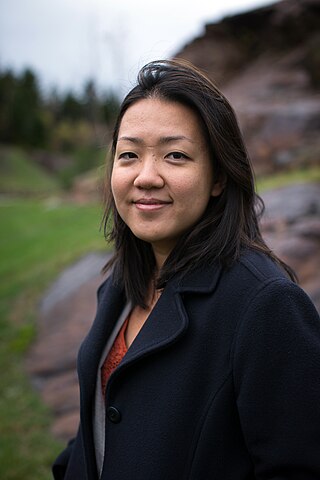Related Research Articles

Frank Thomson "Tom" Leighton is an American mathematician who is the CEO of Akamai Technologies, the company he co-founded with Daniel Lewin in 1998, and a professor of applied mathematics at the Massachusetts Institute of Technology (MIT). He is a member of the Computer Science and Artificial Intelligence Laboratory (CSAIL) at MIT.

Daphne Koller is an Israeli-American computer scientist. She was a professor in the department of computer science at Stanford University and a MacArthur Foundation fellowship recipient. She is one of the founders of Coursera, an online education platform. Her general research area is artificial intelligence and its applications in the biomedical sciences. Koller was featured in a 2004 article by MIT Technology Review titled "10 Emerging Technologies That Will Change Your World" concerning the topic of Bayesian machine learning.

Mary Lou Jepsen is a technical executive and inventor in the fields of display, imaging, and computer hardware. She was the co-founder and first chief technology officer of One Laptop per Child (OLPC), and later founded Pixel Qi in Taipei, Taiwan, focused on the design and manufacture of displays. She founded and led two moonshots at Google X, and was an executive at Facebook / Oculus VR, leading an effort to advance virtual reality.
Angela M. Belcher is a materials scientist, biological engineer, and the James Mason Crafts Professor of Biological Engineering and Materials Science at the Massachusetts Institute of Technology (MIT) in Cambridge, Massachusetts, United States. She is director of the Biomolecular Materials Group at MIT, a member of the Koch Institute for Integrative Cancer Research, and a 2004 MacArthur Fellow. In 2019, she was named head of the Department of Biological Engineering at MIT. She was elected a member of the National Academy of Sciences in 2022.
Lorrie Faith Cranor is an American academic who is the FORE Systems Professor of Computer Science and Engineering and Public Policy at Carnegie Mellon University, Director and Bosch Distinguished Professor in Security and Privacy Technologies of Carnegie Mellon Cylab, and director of the Carnegie Mellon Usable Privacy and Security Laboratory. She has served as Chief Technologist of the Federal Trade Commission, and she was formerly a member of the Electronic Frontier Foundation Board of Directors. Previously she was a researcher at AT&T Labs-Research and taught in the Stern School of Business at New York University. She has authored over 110 research papers on online privacy, phishing and semantic attacks, spam, electronic voting, anonymous publishing, usable access control, and other topics.

Aaron Koblin is an American digital media artist and entrepreneur best known for his use of data visualization and his work in crowdsourcing, virtual reality, and interactive film. He is co-founder and president of virtual reality company Within, founded with Chris Milk. The company created the popular virtual reality fitness app Supernatural, which was acquired by Meta in 2023. Formerly he created and lead the Data Arts Team at Google in San Francisco, California from 2008 to 2015.

The Scientific Computing and Imaging (SCI) Institute is a permanent research institute at the University of Utah that focuses on the development of new scientific computing and visualization techniques, tools, and systems with primary applications to biomedical engineering. The SCI Institute is noted worldwide in the visualization community for contributions by faculty, alumni, and staff. Faculty are associated primarily with the School of Computing, Department of Bioengineering, Department of Mathematics, and Department of Electrical and Computer Engineering, with auxiliary faculty in the Medical School and School of Architecture.

Genevieve Bell is the Vice-Chancellor of the Australian National University and an Australian cultural anthropologist. She is best known for her work at the intersection of cultural practice research and technological development, and for being an industry pioneer of the user experience field. Bell was the inaugural director of the Autonomy, Agency and Assurance Innovation Institute (3Ai), which was co-founded by the Australian National University (ANU) and CSIRO’s Data61, and a Distinguished Professor of the ANU College of Engineering, Computing and Cybernetics. From 2021 to December 2023, she was the inaugural Director of the new ANU School of Cybernetics. She also holds the university's Florence Violet McKenzie Chair, and is the first SRI International Engelbart Distinguished Fellow. She is widely published, and holds 13 patents.

Ayah Bdeir is a Lebanese-Canadian entrepreneur, inventor, and innovator. She is the inventor and CEO of littleBits, a company that produces modular electronics kits for education and prototyping. She is also the co-founder of Daleel Thawra, a directory of protests, initiatives, donations for the Lebanese Revolution.

Christopher Ray Johnson is an American computer scientist. He is a distinguished professor of computer science at the University of Utah, and founding director of the Scientific Computing and Imaging Institute (SCI). His research interests are in the areas of scientific computing and scientific visualization.
Corinna E. Lathan is an American entrepreneur, engineer, and social activist. She is the author of InventingThe Future: Stories from a Techno Optimist. Dr. Lathan is currently CEO of De Oro Devices. She is also the Co-Founder, and former CEO and Board Chair of AnthroTronix, Inc., a biomedical research and development company headquartered in Silver Spring, Maryland, USA. Lathan is recognized for her work on digital health software and assistive technology.

Catherine Havasi is an American scientist who specializes in artificial intelligence (AI) at MIT Media Lab. She co-founded and was CEO of AI company, Luminoso for 8 years. Havasi was a member of the MIT group engaged in the Open Mind Common Sense AI project that created the natural language AI program ConceptNet. Havasi is currently the Chief of Innovation and Technology Strategy at Babel Street, AI-enabled data-to-knowledge platform.
Claudio Silva is a Brazilian American computer scientist and data scientist. He is a professor of computer science and engineering at the New York University Tandon School of Engineering, the head of disciplines at the NYU Center for Urban Science and Progress (CUSP) and affiliate faculty member at NYU's Courant Institute of Mathematical Sciences. He co-developed the open-source data-exploration system VisTrails with his wife Juliana Freire and many other collaborators. He is a former chair of the executive committee for the IEEE Computer Society Technical Committee on Visualization and Graphics.

The Kahlert School of Computing is a school within the College of Engineering at the University of Utah in Salt Lake City, Utah.

Hanspeter Pfister is a Swiss computer scientist. He is the An Wang Professor of Computer Science at the Harvard John A. Paulson School of Engineering and Applied Sciences and an affiliate faculty member of the Center for Brain Science at Harvard University. His research in visual computing lies at the intersection of scientific visualization, information visualization, computer graphics, and computer vision and spans a wide range of topics, including biomedical image analysis and visualization, image and video analysis, and visual analytics in data science.
Janet Iwasa is an American data visualization expert and assistant professor of biochemistry at the University of Utah.
Carol Elizabeth Reiley is an American business executive, computer scientist, and model. She is a pioneer in teleoperated and autonomous robot systems in surgery, space exploration, disaster rescue, and self-driving cars. Reiley has worked at Intuitive Surgical, Lockheed Martin, and General Electric. She co-founded, invested in, and was president of Drive.ai, and is now CEO of a healthcare startup, a creative advisor for the San Francisco Symphony, and a brand ambassador for Guerlain Cosmetics. She is a published children's book author, the first female engineer on the cover of MAKE magazine, and is ranked by Forbes, Inc, and Quartz as a leading entrepreneur and influential scientist.
Robin Roberson Murphy is an American computer scientist and roboticist. She is the Raytheon Professor of Computer Science and Engineering at Texas A&M University. She is known as a founder of the fields of rescue robotics and human-robot interaction and for inserting robots into disasters. Her case studies of how unmanned systems under perform in the field led cognitive systems engineering researcher David Woods to pose the (Robin) Murphy's Law of Autonomy: a deployment of robotic systems will fall short of the target level of autonomy, creating or exacerbating a shortfall in mechanisms for coordination with human problem holders. Her TED talk “These Robots Come to the Rescue After a Disaster” was listed in TED Talks: The Official TED Guide to Public Speaking as one of the examples of a good TED talk. Murphy is also known for using science fiction as an innovative method of teaching artificial intelligence and robotics.

Leila A. Takayama is an associate professor of Human–computer interaction at the University of California, Santa Cruz. She has previously held positions at Google X and Willow Garage. She was elected as a World Economic Forum Young Global Leader in 2013.
Alicia Chong Rodriguez is an engineer and inventor who is founder of Bloomer Tech. She designs wearable technologies that can allow for personalized healthcare, particularly in the treatment of cardiovascular disease in women. She was named a TED fellow in 2021.
References
- ↑ Rajpurohit, Anmol (January 2015). "Interview: Miriah Meyer, Univ. of Utah on the Art and Science of Visualization". KDnuggets. Retrieved 5 June 2017.
- ↑ "IEEE-USA Engineering Mass Media Fellows Program". IEEE USA Communications. IEEE. Retrieved 5 June 2017.
- ↑ Singer, Emily (2011). "Innovator Under 35: Miriah Meyer, 34". MIT Technology Review.
- ↑ Cain, Patrick (27 April 2012). "100 Most Creative People: 24. Miriah Meyer". Fast Company. Retrieved 5 June 2017.
- ↑ Hines, Kenneth (12 November 2012). "Miriah Meyer Named a 2013 TED Fellow » CCC Blog". Computing Community Consortium Blog. Retrieved 5 June 2017.